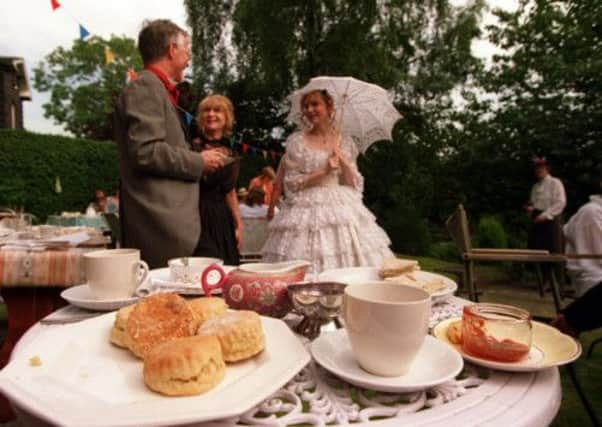Maths and scones: The perfect cream tea


But now a maths expert at a Yorkshire university has got the quintessentially English custom down to a science.
Dr Eugenia Cheng, from the University of Sheffield’s school of mathematics and statistics, has cooked up a formula for what she claims is the ideal combination of scones, jam and cream.
Advertisement
Hide AdAdvertisement
Hide AdThe findings of her research also weigh into the age-old argument of which type of cream to use and whether it should be spread on to the scone before or after the jam.
Using a 2:1:1 weight ratio, with which an average 70g scone would require 35g of jam and 35g of cream, Dr Cheng’s equation uses the radius of the scone to calculate how thickly the accompaniments should be spread.
Dr Cheng said: “Building a good scone is like building a good sandcastle – you need a wider base, and then it needs to get narrower as it goes up so that it doesn’t collapse or drip.
“A rim of around 5mm is required around the jam, to prevent mess, and then a further rim of 5mm for when the cream is placed on top of the jam.”
Advertisement
Hide AdAdvertisement
Hide AdClotted cream should be used, she concluded, as the volume of whipped cream needed for the correct weight ratio would be thicker than the scone, making the whole delicacy too tall to fit into the average mouth.
Dr Cheng, who is renowned for using food to explain complicated maths to her students in schools and lectures, said: “This formula shows that maths is relevant in our everyday world, and that maths can give us a logical explanation for something we’ve discovered by gut feeling, like that clotted cream is better than whipped cream.”
The total thickness of the scone, with all its elements, should be around 2.8cm to allow for a relaxed open width of the mouth, the research found.
And the jam should be spread on first as it is less dense than the cream and could otherwise run off, Dr Cheng concluded.
Advertisement
Hide AdAdvertisement
Hide AdHer findings support the traditional Cornish way of serving the afternoon treat rather than the rival Devon method.
Nicholas Rodda, managing director of Rodda’s Cornish Clotted Cream, which commissioned the research, said: “For a perfect cream tea, you need to have the right quantities of each ingredient and prepare them in the right way.
“The aim of this formula is to help ensure that no matter where you are in the country you should always be able to enjoy the perfect serve for a cream tea.
“It’s simply about the winning formula for these traditional ingredients; jam and scone, with Cornish clotted cream being the essential crowning glory.”
Advertisement
Hide AdAdvertisement
Hide AdCream tea made to Dr Cheng’s formula will be showcased at the Royal Cornwall Show next weekend.
TV chef Rosemary Shrager said baking scones was a science but how to serve them was a matter of personal taste.
“Baking scones is a science, but it’s a fun one. Of course you have to weigh ingredients and ensure the oven is the correct temperature, but these things become second nature the more frequently you do them,” she said.
“As for the correct cream to jam ratio – that is less science and more personal preference. Have plenty of both – and home made jam made from freshly picked, locally produced strawberries.”
Advertisement
Hide AdAdvertisement
Hide AdA spokeswoman for Bettys said the afternoon tea served in its tearooms throughout the region – using Yorkshire clotted cream – was more of an art than a science.
“After all, we’ve had almost 100 years in business to perfect it,” she said.
“For us it’s one of life’s exquisite little luxuries that delights all the senses and is rather hard to deconstruct.”
Mark Oglesby, owner of Goldsborough Hall near Knaresborough, where lavish Royal afternoon teas are served up in the Jacobean library and terrace of Princess Mary’s former home, said the findings of the research were fascinating and contained some excellent advice.
Advertisement
Hide AdAdvertisement
Hide Ad“We only use the finest clotted cream, rather than whipped cream, and home-made strawberry jam served separately, so the debate over jam or cream first is then left to the customer’s preference,” he said.
“When it comes to quantity and application there is a lot of good sense in there and I think their conclusion is not far off the mark, although there is also the question of whether the scone should be buttered.”
He added: “The university findings are certainly great advice that we can pass on to guests, so they can build the perfect scone.”